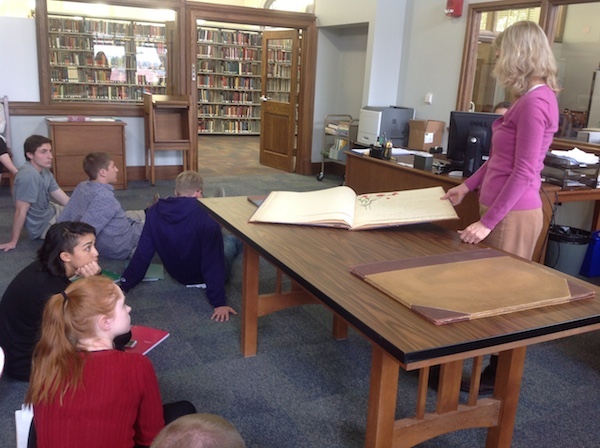Freshmen gain perspective on changes at Madison
News
Freshmen in Dr. Vanessa Rouillon’s GWRTC 103 class are examining student life and culture at Madison over the years and making connections across generations using Special Collections at Carrier Library.
For their required semester research project, Rouillon’s students visit the university archives, where they discover a treasure trove of old photographs, yearbooks, newspaper articles, course catalogs, student handbooks, correspondence, records of social events and other historical items dating back to the founding of the school in 1908. In addition to writing a research paper on a topic of their choice, the students must produce a short video based on their findings.
“We use the collections as primary texts to help answer the question, what can we say about student life and culture here 50 or 100 years ago?” said Rouillon, who is interested in visual rhetoric. “We flip the word ‘text’ upside down. A photograph of students on the Quad or a recording of the Madison Glee Club becomes a text to be read.”
Lynn Eaton, special collections librarian at JMU, said first-year students are especially drawn to texts that show how rules and regulations governing student conduct have changed over time. “They’ll look at a dance card from the 1940s or the student handbook from 1964 and say, ‘Wow, things were really different back then.’”
Rouillon believes it’s important to anchor her students and help them develop a sense of place early on in their academic careers. “I want them to react to what they’re seeing and begin thinking about their own sense of identity and how it compares to those who have come before them.” She also feels it’s her responsibility to introduce students to campus resources. “We could still be working on a research paper, and they could go online and get sources and never have to leave their dorm room. But I think they learn more by experiencing these collections firsthand.”
"It’s our responsibility to know where we are and the culture behind the place we are going to live for the next few years of our lives. It’s easy to see how significant the information really is in molding us as JMU students." — Danielle Dyjak
The students are encouraged to hold the items, leaf through the pages and take notes, and they’re allowed to photograph or scan them using a smartphone or tablet for use in the video assignment. “We employ basic tools and have already been training ourselves in documentary photography, so the video is heavy on still images,” Rouillon said. The students provide their own narration.
Sophomore Danielle Dyjak, who completed the course in the spring, came to appreciate the perspective that the assignment offers. “If we don’t know how things used to be, how can we appreciate what we have now?” she said. “It’s our responsibility to know where we are and the culture behind the place we are going to live for the next few years of our lives. It’s easy to see how significant the information really is in molding us as JMU students.”
###

